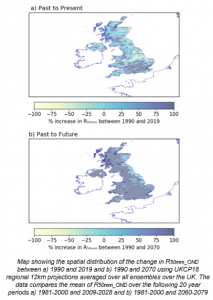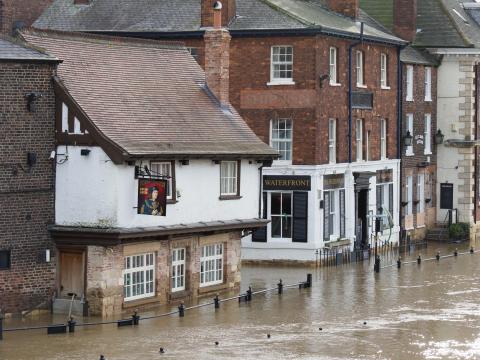The problem
The UK has seen many big flooding events since the start of the 21st century, including during the winters of 2013/14, 2015/16 and 2019/20, the autumn of 2000, 2019, and the summer of 2007. The autumn of 2019 was the wettest season on record for South Yorkshire, with several extreme rainfall events leading to severe flooding. What made this event particularly exceptional and unprecedented was the extreme rainfall totals seen in such a short amount of time. On 7th November some locations recorded up to 82.2 mm of rainfall in 24-hours, over a month’s worth of rainfall, and followed a similar event on 25th October where some locations recorded 24-hour totals of almost 50mm. Severe impacts followed including two rivers bursting their banks leading to one death, over 500 properties being flooded, 1200 households being evacuated and potential insurance losses of up to £120 million.
Scientific evidence shows that the UKs climate is changing and will continue to change into the future. For example, observational records show that extremely wet days have increased in intensity for the UK by 17% when comparing the 1960–1990 and 2008–2017 averages. Several attribution studies have also shown that for heavy rainfall events causing flooding in the UK this century, both atmospheric circulation and anthropogenic climate change played a role. Uncertainty remains on how weather extremes will change in the future, and the ability to better characterise these is important for developing effective strategies to reduce future climate risks and impacts. This will allow for better adaptation planning in different sectors to support the increase in resilience of the UK to future climate variability and change.
The approach
A new analysis has been made of short period intense rainfall, the first of its type for the UK, using high resolution climate model simulations to estimate the changing risk of the extreme rainfall amounts of the type that led to severe flooding in Yorkshire in November 2019. It investigates how the frequency of these extreme rainfall events has already changed UK wide and how much it is projected to change in the future. The study has developed a new index (R50mm_OND) that represents the number of days during October/November/December with daily precipitation totals of over 50 mm.
The findings
The results show a significant and substantial impact of human-induced greenhouse gas emissions on the risk of intense short-period rainfall in the UK. Extreme daily rainfall totals in excess of 50 mm/day on a UK wide scale, seen most often in the seasons of autumn and winter, have increased noticeably between 1960-2020 with the R50mm_OND increasing in the observations by 60% between the start of the 20th and 21st centuries. UKCP18 projections (12 km regional climate model under RCP 8.5) show that between 2019 and 2070, R50mm_OND is projected to increase by a further 85%. The projections also show increases in the number of these events in almost all regions of the UK including central and eastern England, where such events have not yet been seen in the observational record.

Next Steps
This research has provided important policy relevant findings that can inform the development of effective strategies to reduce future climate risks and impacts. The results have undergone peer-review and are now published in the journal Weather and Climate Extremes. A 1-page non-technical summary and supporting infographic (view on project page) have also been developed to help communicate the findings. Further opportunities are being sought to ensure the results are effectively disseminated to policy makers and the wider public. In the next phase of research, we will examine the link between the increase in the frequency of these extreme rainfall events and their associated flood impacts for different regions of the UK. There is also work underway examining how circulation changes are currently impacting and are likely to impact UK autumn rainfall in the future.
By Dan Cotterill & Peter Stott for ‘Impact Event Attribution’, part of the ‘Improving Climate Hazard Information’ Work Package.
Reference
Cotterill, D., Stott, P., Christidis, N., Kendon, E., 2021, Increase in the frequency of extreme daily precipitation in the United Kingdom in autumn, Weather and Climate Extremes

